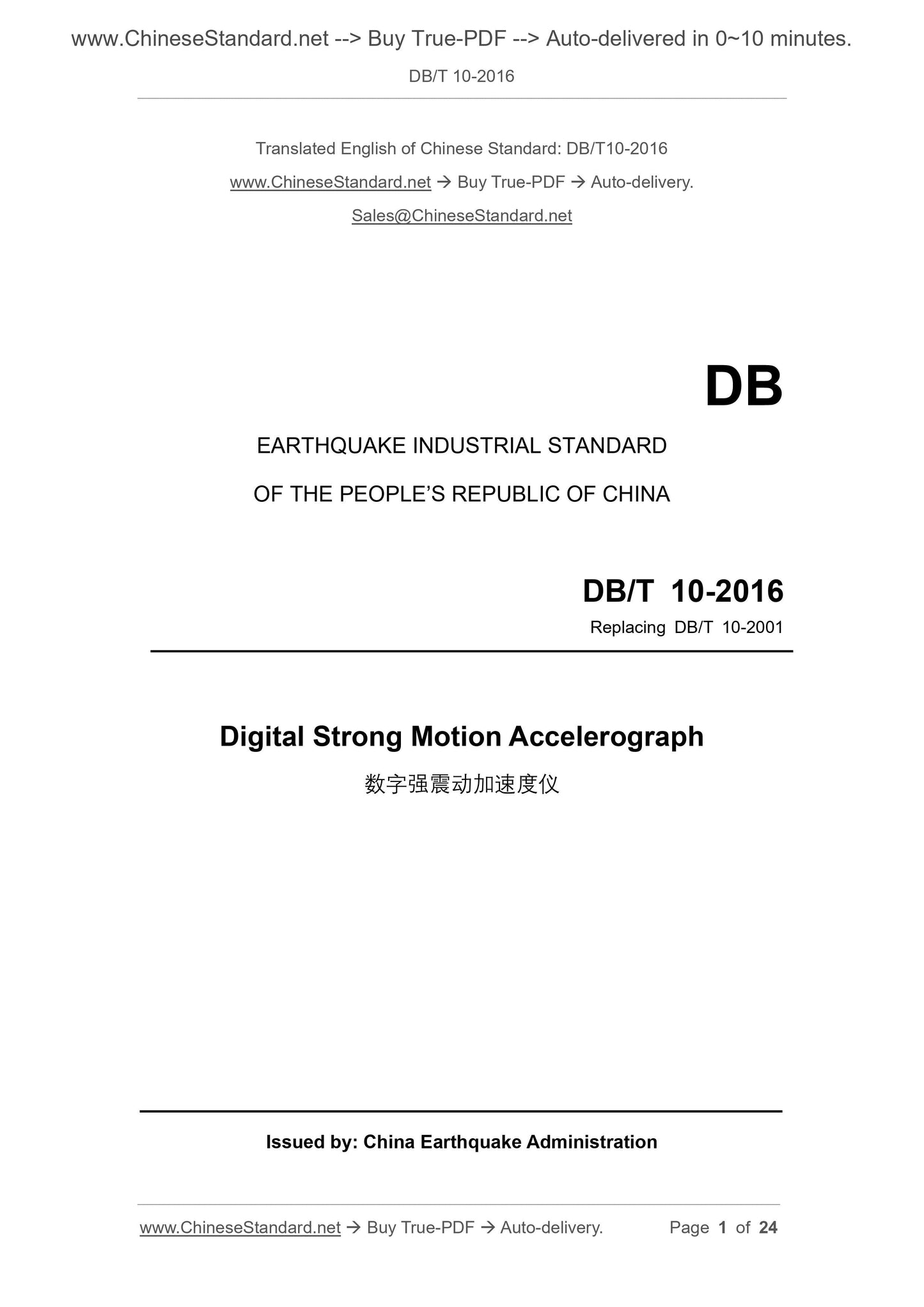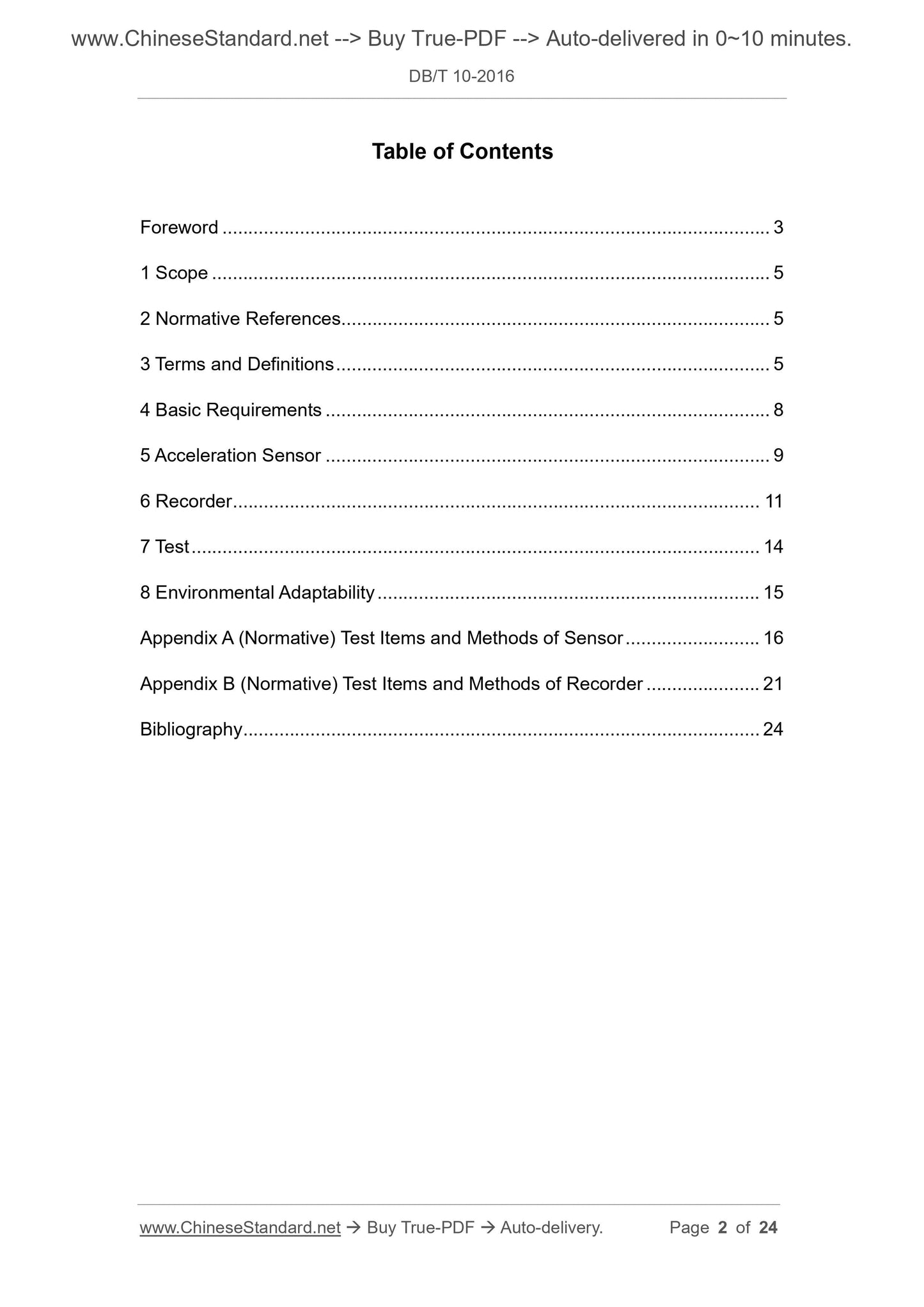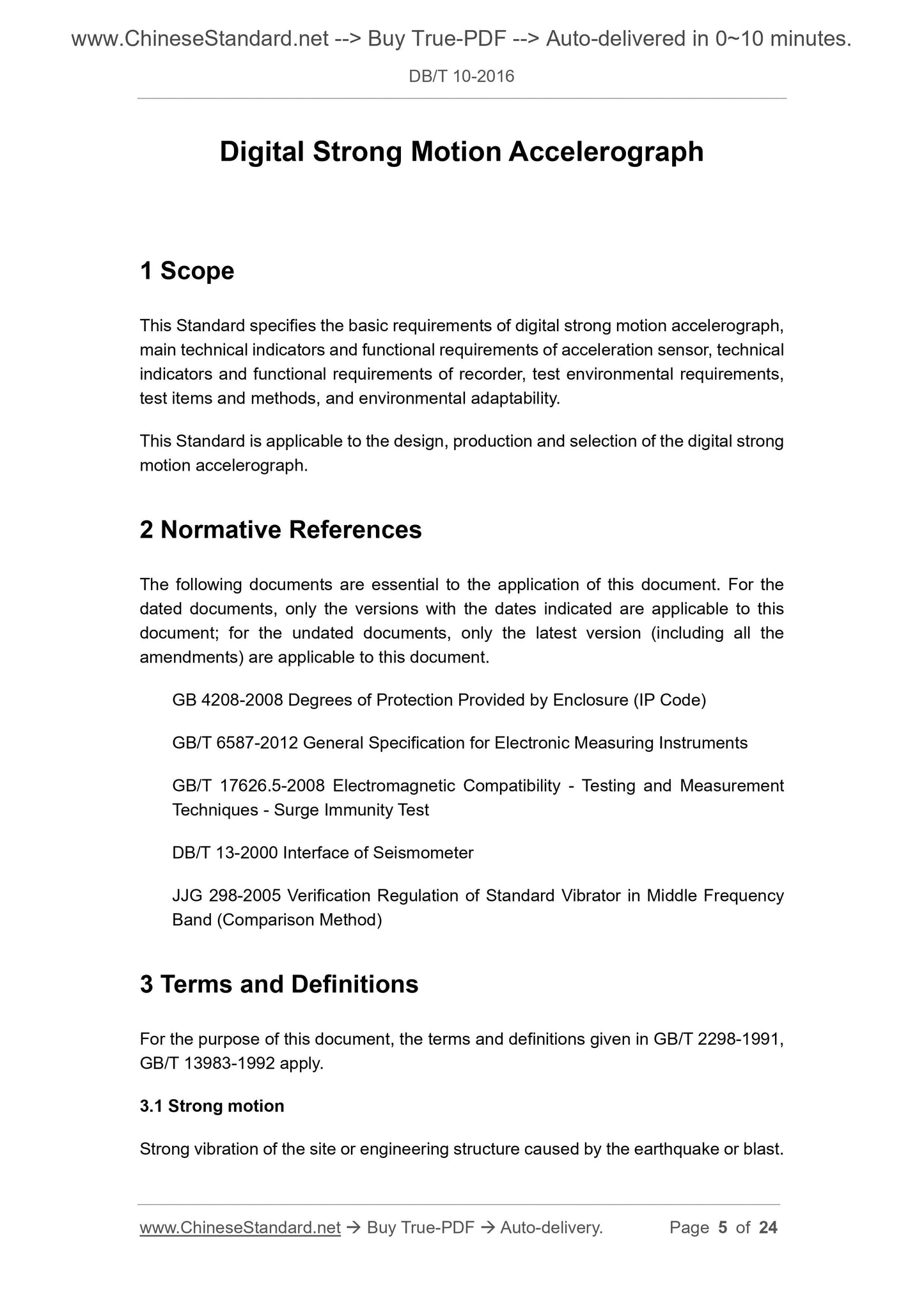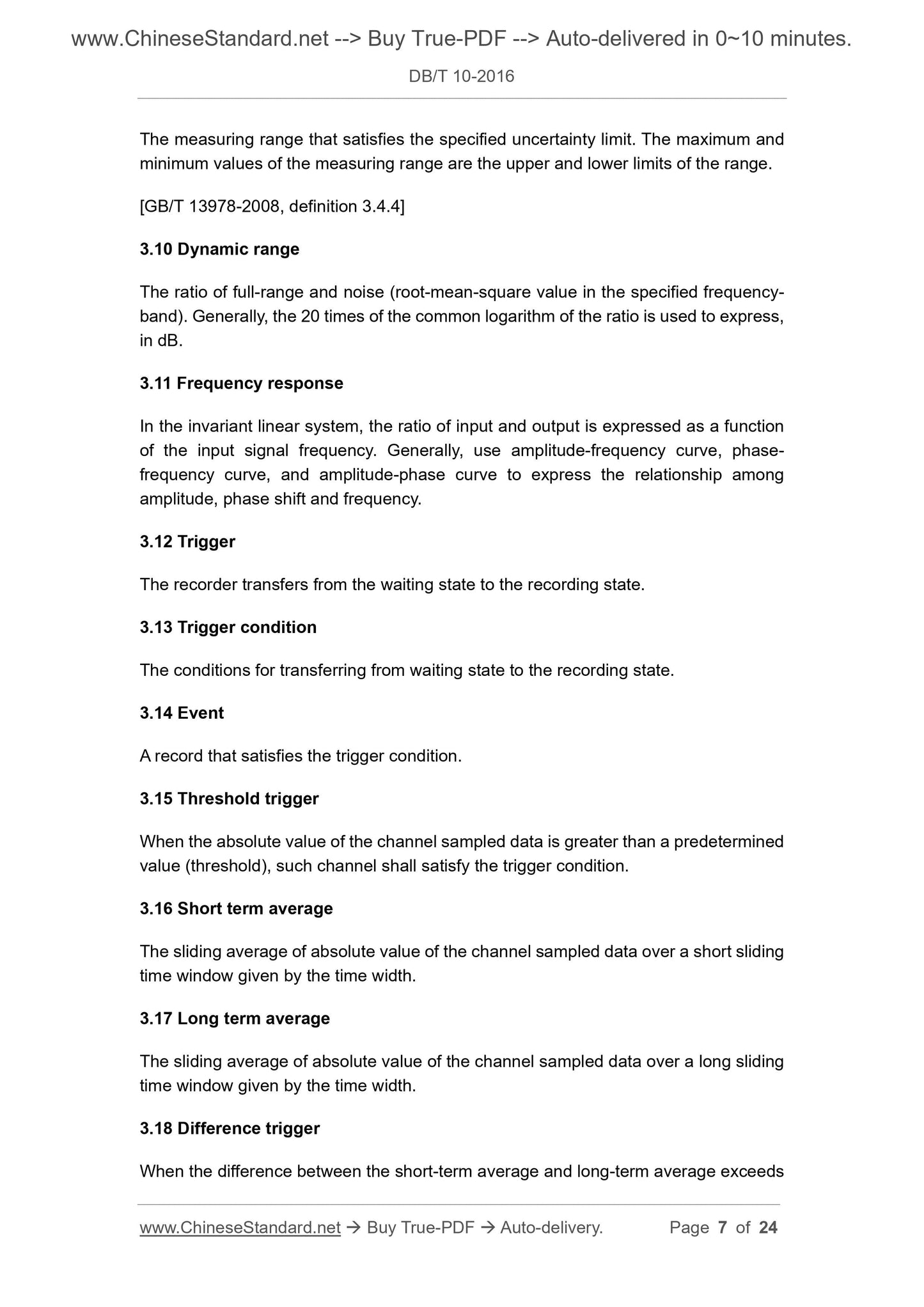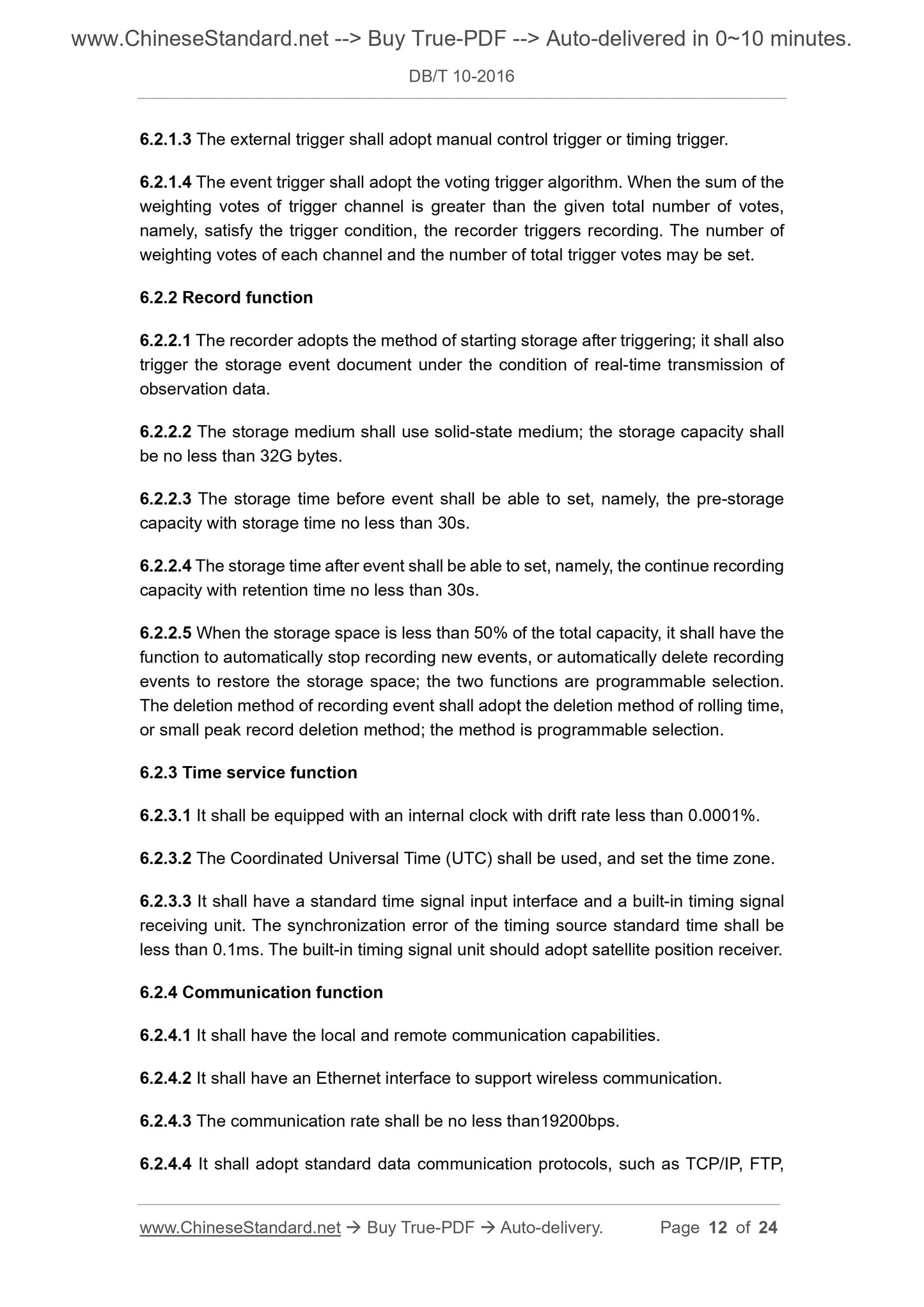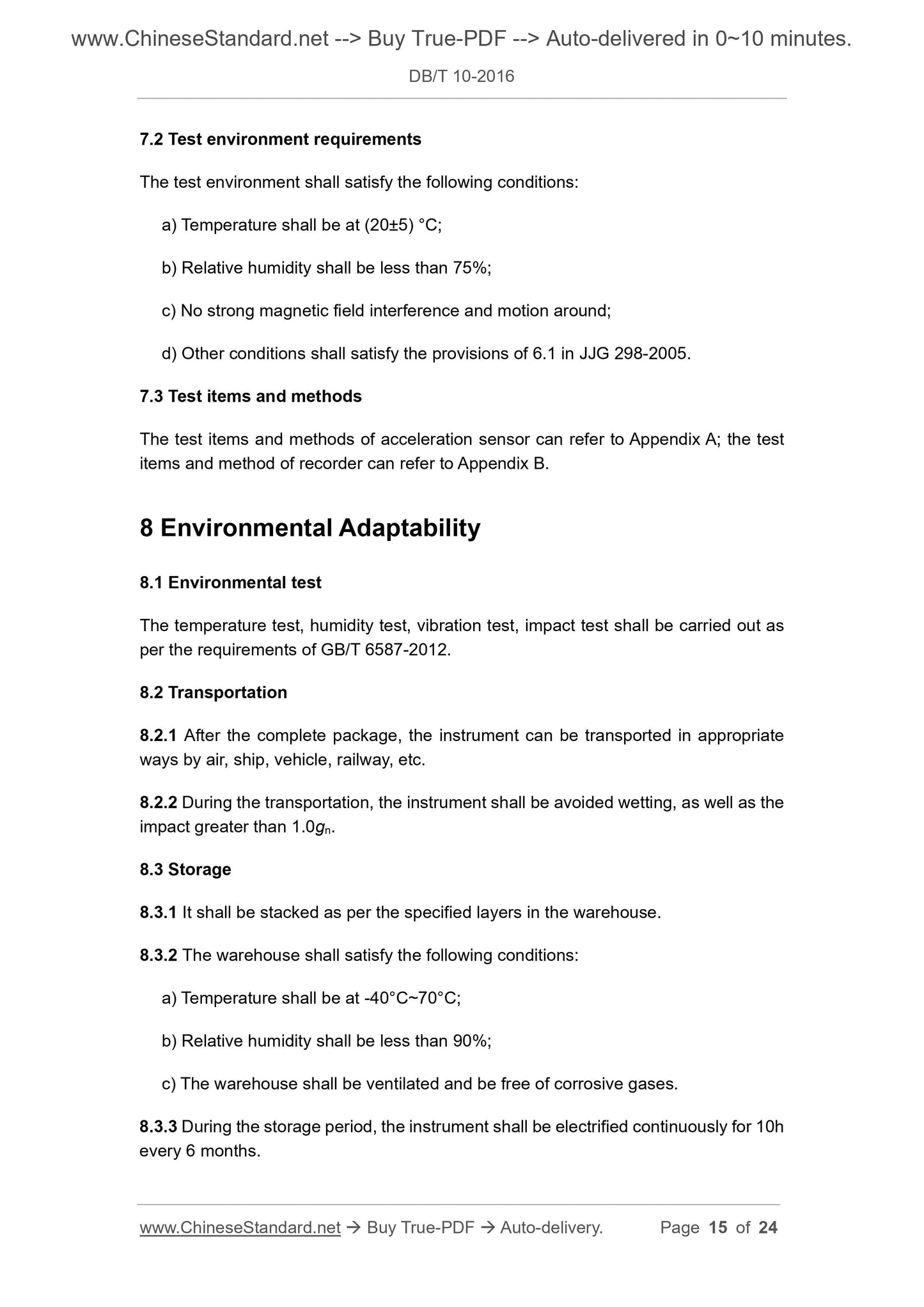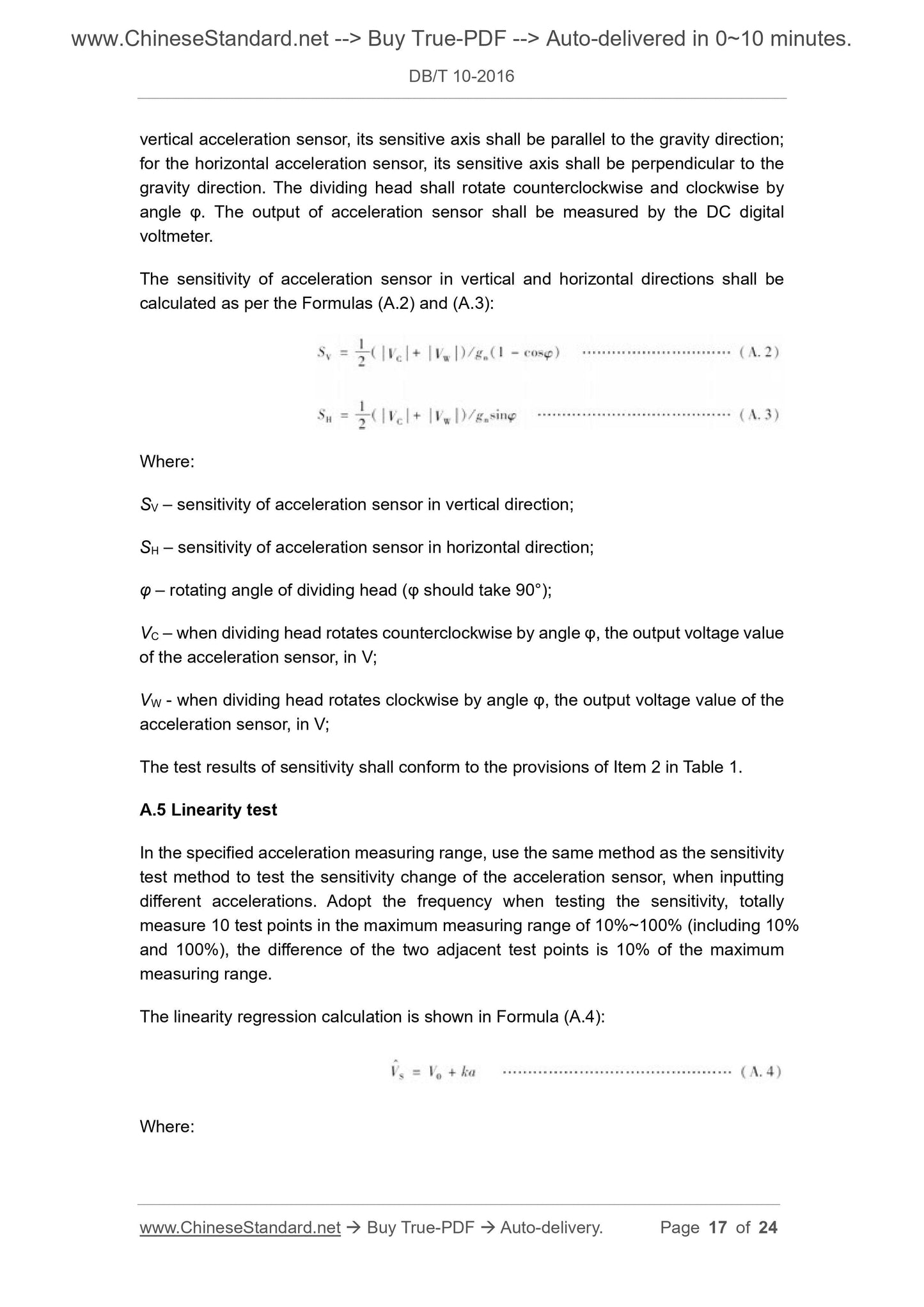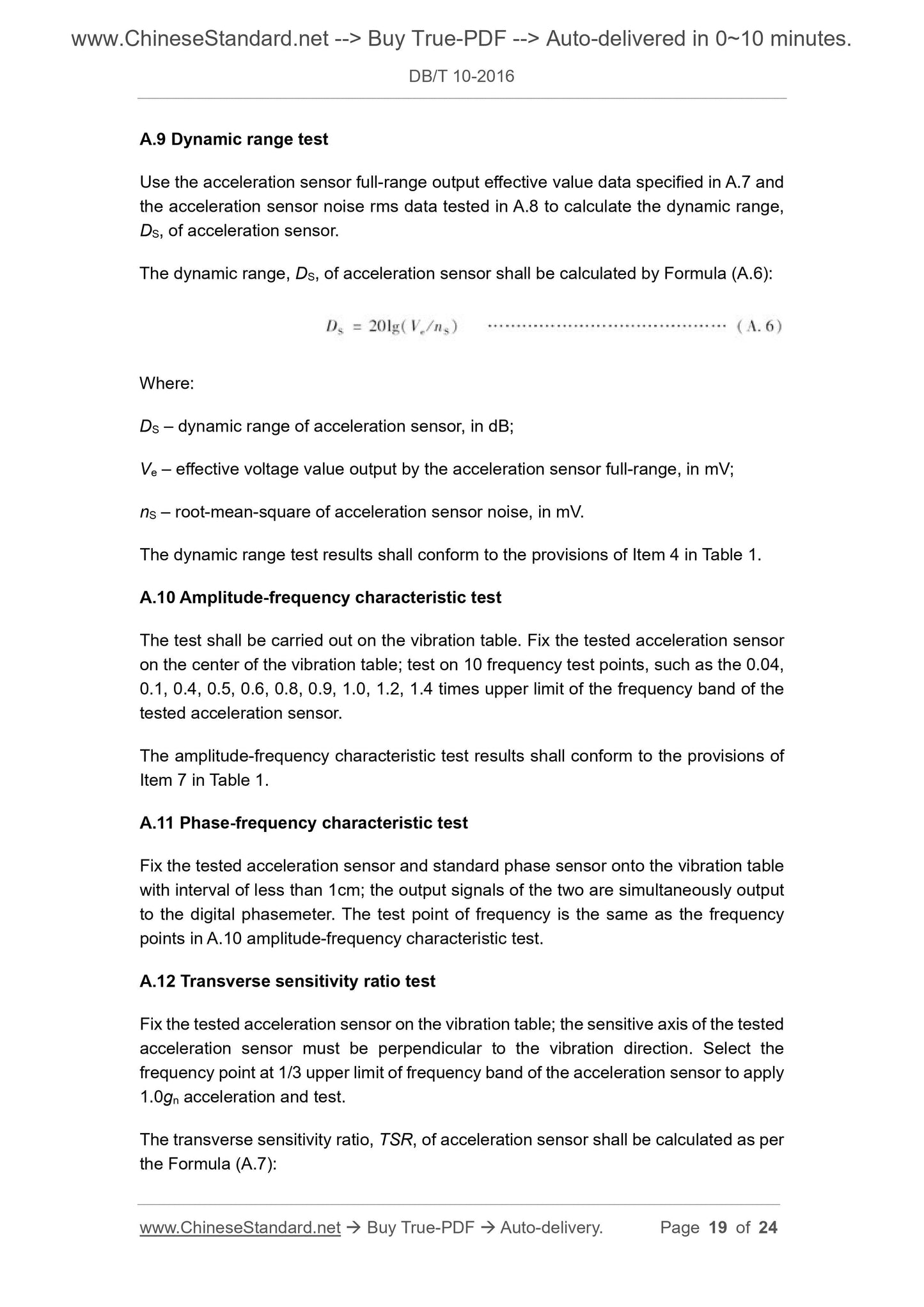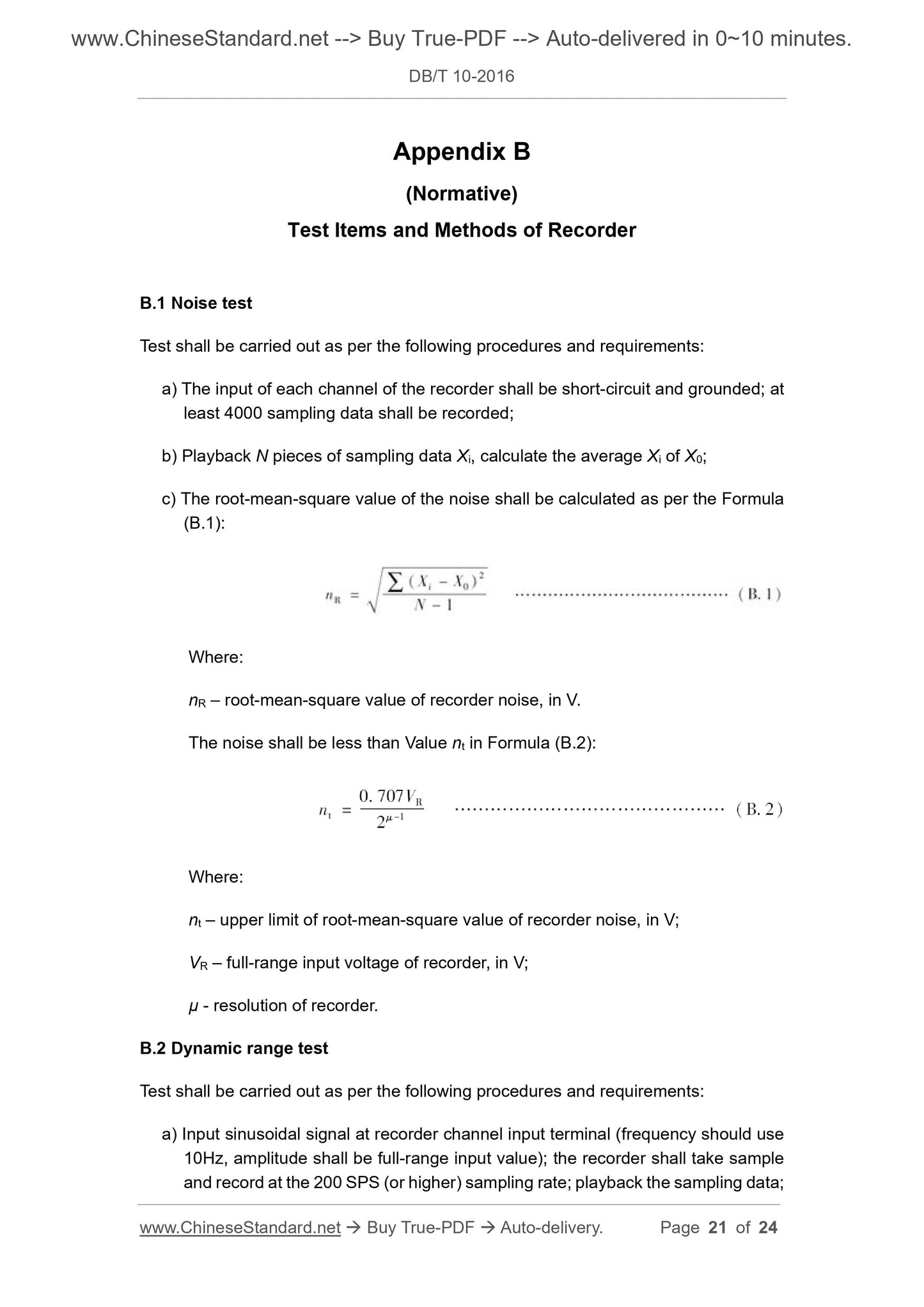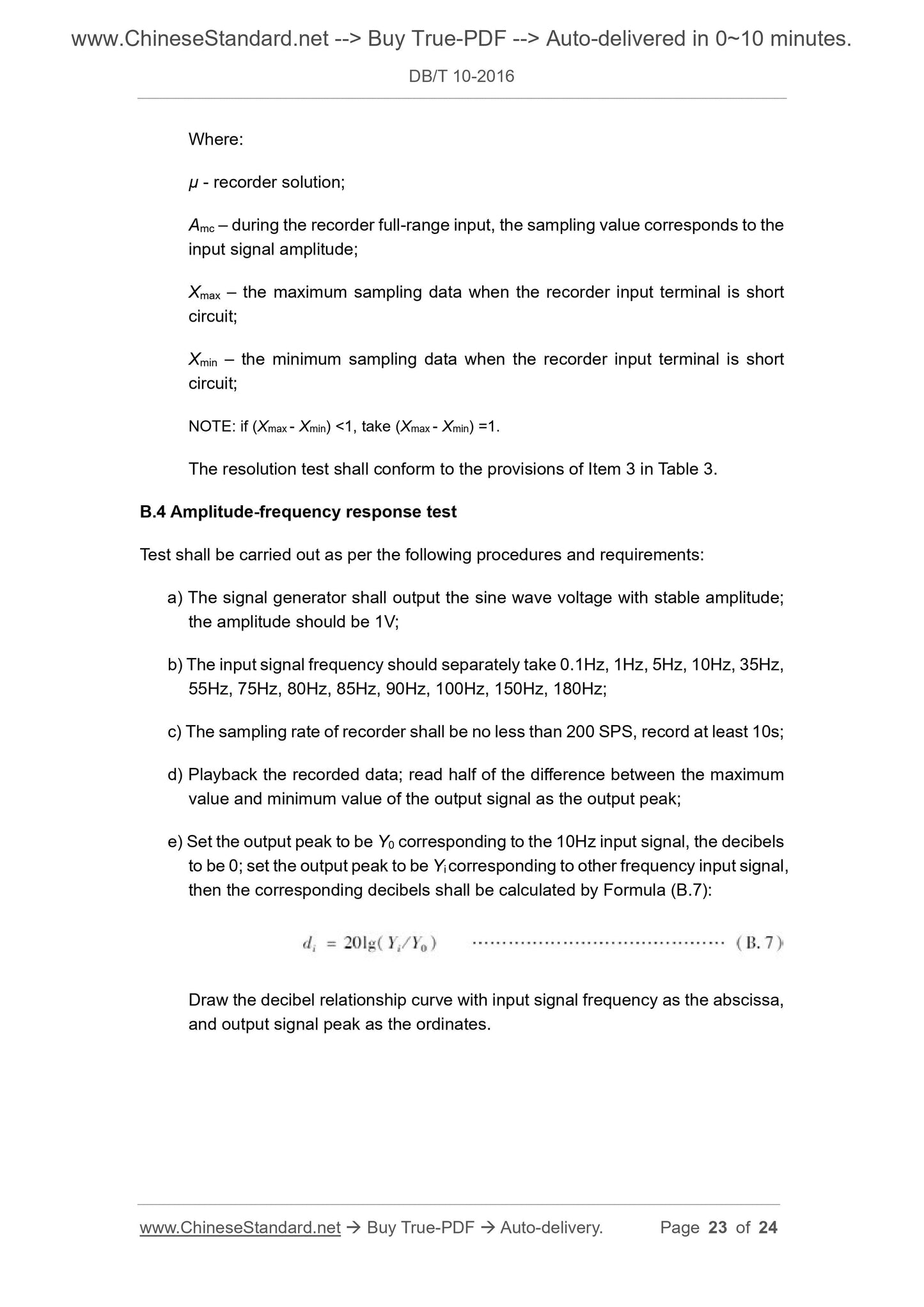1
/
of
10
www.ChineseStandard.us -- Field Test Asia Pte. Ltd.
DB/T 10-2016 English PDF (DB/T10-2016)
DB/T 10-2016 English PDF (DB/T10-2016)
Regular price
$305.00
Regular price
Sale price
$305.00
Unit price
/
per
Shipping calculated at checkout.
Couldn't load pickup availability
DBT10-2016:
Delivery: 9 seconds. Download (& Email) true-PDF + Invoice.
Get Quotation: Click DBT10-2016 (Self-service in 1-minute)
Historical versions (Master-website): DBT10-2016
Preview True-PDF (Reload/Scroll-down if blank)
DB/T 10-2016
EARTHQUAKE INDUSTRIAL STANDARD
OF THE PEOPLE’S REPUBLIC OF CHINA
Replacing DB/T 10-2001
Digital Strong Motion Accelerograph
Issued by: China Earthquake Administration
Table of Contents
Foreword ... 3
1 Scope ... 5
2 Normative References ... 5
3 Terms and Definitions ... 5
4 Basic Requirements ... 8
5 Acceleration Sensor ... 9
6 Recorder ... 11
7 Test ... 14
8 Environmental Adaptability ... 15
Appendix A (Normative) Test Items and Methods of Sensor ... 16
Appendix B (Normative) Test Items and Methods of Recorder ... 21
Bibliography ... 24
Digital Strong Motion Accelerograph
1 Scope
This Standard specifies the basic requirements of digital strong motion accelerograph,
main technical indicators and functional requirements of acceleration sensor, technical
indicators and functional requirements of recorder, test environmental requirements,
test items and methods, and environmental adaptability.
This Standard is applicable to the design, production and selection of the digital strong
motion accelerograph.
2 Normative References
The following documents are essential to the application of this document. For the
dated documents, only the versions with the dates indicated are applicable to this
document; for the undated documents, only the latest version (including all the
amendments) are applicable to this document.
GB 4208-2008 Degrees of Protection Provided by Enclosure (IP Code)
GB/T 6587-2012 General Specification for Electronic Measuring Instruments
GB/T 17626.5-2008 Electromagnetic Compatibility - Testing and Measurement
Techniques - Surge Immunity Test
DB/T 13-2000 Interface of Seismometer
JJG 298-2005 Verification Regulation of Standard Vibrator in Middle Frequency
Band (Comparison Method)
3 Terms and Definitions
For the purpose of this document, the terms and definitions given in GB/T 2298-1991,
GB/T 13983-1992 apply.
3.1 Strong motion
Strong vibration of the site or engineering structure caused by the earthquake or blast.
The measuring range that satisfies the specified uncertainty limit. The maximum and
minimum values of the measuring range are the upper and lower limits of the range.
[GB/T 13978-2008, definition 3.4.4]
3.10 Dynamic range
The ratio of full-range and noise (root-mean-square value in the specified frequency-
band). Generally, the 20 times of the common logarithm of the ratio is used to express,
in dB.
3.11 Frequency response
In the invariant linear system, the ratio of input and output is expressed as a function
of the input signal frequency. Generally, use amplitude-frequency curve, phase-
frequency curve, and amplitude-phase curve to express the relationship among
amplitude, phase shift and frequency.
3.12 Trigger
The recorder transfers from the waiting state to the recording state.
3.13 Trigger condition
The conditions for transferring from waiting state to the recording state.
3.14 Event
A record that satisfies the trigger condition.
3.15 Threshold trigger
When the absolute value of the channel sampled data is greater than a predetermined
value (threshold), such channel shall satisfy the trigger condition.
3.16 Short term average
The sliding average of absolute value of the channel sampled data over a short sliding
time window given by the time width.
3.17 Long term average
The sliding average of absolute value of the channel sampled data over a long sliding
time window given by the time width.
3.18 Difference trigger
When the difference between the short-term average and long-term average exceeds
6.2.1.3 The external trigger shall adopt manual control trigger or timing trigger.
6.2.1.4 The event trigger shall adopt the voting trigger algorithm. When the sum of the
weighting votes of trigger channel is greater than the given total number of votes,
namely, satisfy the trigger condition, the recorder triggers recording. The number of
weighting votes of each channel and the number of total trigger votes may be set.
6.2.2 Record function
6.2.2.1 The recorder adopts the method of starting storage after triggering; it shall also
trigger the storage event document under the condition of real-time transmission of
observation data.
6.2.2.2 The storage medium shall use solid-state medium; the storage capacity shall
be no less than 32G bytes.
6.2.2.3 The storage time before event shall be able to set, namely, the pre-storage
capacity with storage time no less than 30s.
6.2.2.4 The storage time after event shall be able to set, namely, the continue recording
capacity with retention time no less than 30s.
6.2.2.5 When the storage space is less than 50% of the total capacity, it shall have the
function to automatically stop recording new events, or automatically delete recording
events to restore the storage space; the two functions are programmable selection.
The deletion method of recording event shall adopt the deletion method of rolling time,
or small peak record deletion method; the method is programmable selection.
6.2.3 Time service function
6.2.3.1 It shall be equipped with an internal clock with drift rate less than 0.0001%.
6.2.3.2 The Coordinated Universal Time (UTC) shall be used, and set the time zone.
6.2.3.3 It shall have a standard time signal input interface and a built-in timing signal
receiving unit. The synchronization error of the timing source standard time shall be
less than 0.1ms. The built-in timing signal unit should adopt satellite position receiver.
6.2.4 Communication function
6.2.4.1 It shall have the local and remote communication capabilities.
6.2.4.2 It shall have an Ethernet interface to support wireless communication.
6.2.4.3 The communication rate shall be no less than19200bps.
6.2.4.4 It shall adopt standard data communication protocols, such as TCP/IP, FTP,
7.2 Test environment requirements
The test environment shall satisfy the following conditions:
a) Temperature shall be at (20±5) °C;
b) Relative humidity shall be less than 75%;
c) No strong magnetic field interference and motion around;
d) Other conditions shall satisfy the provisions of 6.1 in JJG 298-2005.
7.3 Test items and methods
The test items and methods of acceleration sensor can refer to Appendix A; the test
items and method of recorder can refer to Appendix B.
8 Environmental Adaptability
8.1 Environmental test
The temperature test, humidity test, vibration test, impact test shall be carried out as
per the requirements of GB/T 6587-2012.
8.2 Transportation
8.2.1 After the complete package, the instrument can be transported in appropriate
ways by air, ship, vehicle, railway, etc.
8.2.2 During the transportation, the instrument shall be avoided wetting, as well as the
impact greater than 1.0gn.
8.3 Storage
8.3.1 It shall be stacked as per the specified layers in the warehouse.
8.3.2 The warehouse shall satisfy the following conditions:
a) Temperature shall be at -40°C~70°C;
b) Relative humidity shall be less than 90%;
c) The warehouse shall be ventilated and be free of corrosive gases.
8.3.3 During the storage period, the instrument shall be electrified continuously for 10h
every 6 months.
vertical acceleration sensor, its sensitive axis shall be parallel to the gravity direction;
for the horizontal acceleration sensor, its sensitive axis shall be perpendicular to the
gravity direction. The dividing head shall rotate counterclockwise and clockwise by
angle φ. The output of acceleration sensor shall be measured by the DC digital
voltmeter.
The sensitivity of acceleration sensor in vertical and horizontal directions shall be
calculated as per the Formulas (A.2) and (A.3):
Where:
SV – sensitivity of acceleration sensor in vertical direction;
SH – sensitivity of acceleration sensor in horizontal direction;
φ – rotating angle of dividing head (φ should take 90°);
VC – when dividing head rotates counterclockwise by angle φ, the output voltage value
of the acceleration sensor, in V;
VW - when dividing head rotates clockwise by angle φ, the output voltage value of the
acceleration sensor, in V;
The test results of sensitivity shall conform to the provisions of Item 2 in Table 1.
A.5 Linearity test
In the specified acceleration measuring range, use the same method as the sensitivity
test method to test the sensitivity change of the acceleration sensor, when inputting
different accelerations. Adopt the frequency when testing the sensitivity, totally
measure 10 test points in the maximum measuring range of 10%~100% (including 10%
and 100%), the difference of the two adjacent test points is 10% of the maximum
measuring range.
The linearity regression calculation is shown in Formula (A.4):
Where:
A.9 Dynamic range test
Use the acceleration sensor full-range output effective value data specified in A.7 and
the acceleration sensor noise rms data tested in A.8 to calculate the dynamic range,
DS, of acceleration sensor.
The dynamic range, DS, of acceleration sensor shall be calculated by Formula (A.6):
Where:
DS – dynamic range of acceleration sensor, in dB;
Ve – effective voltage value output by the acceleration sensor full-range, in mV;
nS – root-mean-square of acceleration sensor noise, in mV.
The dynamic range test results shall conform to the provisions of Item 4 in Table 1.
A.10 Amplitude-frequency characteristic test
The test shall be carried out on the vibration table. Fix the tested acceleration sensor
on the center of the vibration table; test on 10 frequency test points, such as the 0.04,
0.1, 0.4, 0.5, 0.6, 0.8, 0.9, 1.0, 1.2, 1.4 times upper limit of the frequency band of the
tested acceleration sensor.
The amplitude-frequency characteristic test results shall conform to the provisions of
Item 7 in Table 1.
A.11 Phase-frequency characteristic test
Fix the tested acceleration sensor and standard phase sensor onto the vibration table
with interval of less than 1cm; the output signals of the two are simultaneously output
to the digital phasemeter. The test point of frequency is the same as the frequency
points in A.10 amplitude-frequency characteristic test.
A.12 Transverse sensitivity ratio test
Fix the tested acceleration sensor on the vibration table; the sensitive axis of the tested
acceleration sensor must be perpendicular to the vibration direction. Select the
frequency point at 1/3 upper limit of frequency band of the acceleration sensor to apply
1.0gn acceleration and test.
The transverse sensitivity ratio, TSR, of acceleration sensor shall be calculated as per
the Formula (A.7):
Appendix B
(Normative)
Test Items and Methods of Recorder
B.1 Noise test
Test shall be carried out as per the following procedures and requirements:
a) The input of each channel of the recorder shall be short-circuit and grounded; at
least 4000 sampling data shall be recorded;
b) Playback N pieces of sampling data Xi, calculate the average Xi of X0;
c) The root-mean-square value of the noise shall be calculated as per the Formula
(B.1):
Where:
nR – root-mean-square value of recorder noise, in V.
The noise shall be less than Value nt in Formula (B.2):
Where:
nt – upper limit of root-mean-square value of recorder noise, in V;
VR – full-range input voltage of recorder, in V;
µ - resolution of recorder.
B.2 Dynamic range test
Test shall be carried out as per the following procedures and requirements:
a) Input sinusoidal signal at recorder channel input terminal (frequency should use
10Hz, amplitude shall be full-range input value); the recorder shall take sample
and record at the 200 SPS (or higher) sampling rate; playback the sampling data;
Where:
µ - recorder solution;
Amc – during the recorder full-range input, the sampling value corresponds to the
input signal amplitude;
Xmax – the maximum sampling data when the recorder input terminal is short
circuit;
Xmin – the minimum sampling data when the recorder input terminal is short
circuit;
NOTE: if (Xmax - Xmin) < 1, take (Xmax - Xmin) =1.
The resolution test shall conform to the provisions of Item 3 in Table 3.
B.4 Amplitude-frequency response test
Test shall be carried out as per the following procedures and requirements:
a) The signal generator shall output the sine wave voltage with stable amplitude;
the amplitude should be 1V;
b) The input signal frequency should separately take 0.1Hz, 1Hz, 5Hz, 10Hz, 35Hz,
55Hz, 75Hz, 80Hz, 85Hz, 90Hz, 100Hz, 150Hz, 180Hz;
c) The sampling rate of recorder shall be no less than 200 SPS, record at least 10s;
d) Playback the recorded data; read half of the difference between the maximum
value and minimum value of the output signal as the output peak;
e) Set the output peak to be Y0 corresponding to the 10Hz input signal, the decibels
to be 0; set the output peak to be Yi corresponding to other frequency input signal,
then the corresponding decibels shall be calculated by Formula (B.7):
Draw the decibel relationship curve with input signal frequency as the abscissa,
and output signal peak as the ordinates.
DB/T 10-2016
EARTHQUAKE INDUSTRIAL STANDARD
OF THE PEOPLE’S REPUBLIC OF CHINA
Replacing DB/T 10-2001
Digital Strong Motion Accelerograph
Issued by: China Earthquake Administration
Table of Contents
Foreword ... 3
1 Scope ... 5
2 Normative References ... 5
3 Terms and Definitions ... 5
4 Basic Requirements ... 8
5 Acceleration Sensor ... 9
6 Recorder ... 11
7 Test ... 14
8 Environmental Adaptability ... 15
Appendix A (Normative) Test Items and Methods of Sensor ... 16
Appendix B (Normative) Test Items and Methods of Recorder ... 21
Bibliography ... 24
Digital Strong Motion Accelerograph
1 Scope
This Standard specifies the basic requirements of digital strong motion accelerograph,
main technical indicators and functional requirements of acceleration sensor, technical
indicators and functional requirements of recorder, test environmental requirements,
test items and methods, and environmen...
Delivery: 9 seconds. Download (& Email) true-PDF + Invoice.
Get Quotation: Click DBT10-2016 (Self-service in 1-minute)
Historical versions (Master-website): DBT10-2016
Preview True-PDF (Reload/Scroll-down if blank)
DB/T 10-2016
EARTHQUAKE INDUSTRIAL STANDARD
OF THE PEOPLE’S REPUBLIC OF CHINA
Replacing DB/T 10-2001
Digital Strong Motion Accelerograph
Issued by: China Earthquake Administration
Table of Contents
Foreword ... 3
1 Scope ... 5
2 Normative References ... 5
3 Terms and Definitions ... 5
4 Basic Requirements ... 8
5 Acceleration Sensor ... 9
6 Recorder ... 11
7 Test ... 14
8 Environmental Adaptability ... 15
Appendix A (Normative) Test Items and Methods of Sensor ... 16
Appendix B (Normative) Test Items and Methods of Recorder ... 21
Bibliography ... 24
Digital Strong Motion Accelerograph
1 Scope
This Standard specifies the basic requirements of digital strong motion accelerograph,
main technical indicators and functional requirements of acceleration sensor, technical
indicators and functional requirements of recorder, test environmental requirements,
test items and methods, and environmental adaptability.
This Standard is applicable to the design, production and selection of the digital strong
motion accelerograph.
2 Normative References
The following documents are essential to the application of this document. For the
dated documents, only the versions with the dates indicated are applicable to this
document; for the undated documents, only the latest version (including all the
amendments) are applicable to this document.
GB 4208-2008 Degrees of Protection Provided by Enclosure (IP Code)
GB/T 6587-2012 General Specification for Electronic Measuring Instruments
GB/T 17626.5-2008 Electromagnetic Compatibility - Testing and Measurement
Techniques - Surge Immunity Test
DB/T 13-2000 Interface of Seismometer
JJG 298-2005 Verification Regulation of Standard Vibrator in Middle Frequency
Band (Comparison Method)
3 Terms and Definitions
For the purpose of this document, the terms and definitions given in GB/T 2298-1991,
GB/T 13983-1992 apply.
3.1 Strong motion
Strong vibration of the site or engineering structure caused by the earthquake or blast.
The measuring range that satisfies the specified uncertainty limit. The maximum and
minimum values of the measuring range are the upper and lower limits of the range.
[GB/T 13978-2008, definition 3.4.4]
3.10 Dynamic range
The ratio of full-range and noise (root-mean-square value in the specified frequency-
band). Generally, the 20 times of the common logarithm of the ratio is used to express,
in dB.
3.11 Frequency response
In the invariant linear system, the ratio of input and output is expressed as a function
of the input signal frequency. Generally, use amplitude-frequency curve, phase-
frequency curve, and amplitude-phase curve to express the relationship among
amplitude, phase shift and frequency.
3.12 Trigger
The recorder transfers from the waiting state to the recording state.
3.13 Trigger condition
The conditions for transferring from waiting state to the recording state.
3.14 Event
A record that satisfies the trigger condition.
3.15 Threshold trigger
When the absolute value of the channel sampled data is greater than a predetermined
value (threshold), such channel shall satisfy the trigger condition.
3.16 Short term average
The sliding average of absolute value of the channel sampled data over a short sliding
time window given by the time width.
3.17 Long term average
The sliding average of absolute value of the channel sampled data over a long sliding
time window given by the time width.
3.18 Difference trigger
When the difference between the short-term average and long-term average exceeds
6.2.1.3 The external trigger shall adopt manual control trigger or timing trigger.
6.2.1.4 The event trigger shall adopt the voting trigger algorithm. When the sum of the
weighting votes of trigger channel is greater than the given total number of votes,
namely, satisfy the trigger condition, the recorder triggers recording. The number of
weighting votes of each channel and the number of total trigger votes may be set.
6.2.2 Record function
6.2.2.1 The recorder adopts the method of starting storage after triggering; it shall also
trigger the storage event document under the condition of real-time transmission of
observation data.
6.2.2.2 The storage medium shall use solid-state medium; the storage capacity shall
be no less than 32G bytes.
6.2.2.3 The storage time before event shall be able to set, namely, the pre-storage
capacity with storage time no less than 30s.
6.2.2.4 The storage time after event shall be able to set, namely, the continue recording
capacity with retention time no less than 30s.
6.2.2.5 When the storage space is less than 50% of the total capacity, it shall have the
function to automatically stop recording new events, or automatically delete recording
events to restore the storage space; the two functions are programmable selection.
The deletion method of recording event shall adopt the deletion method of rolling time,
or small peak record deletion method; the method is programmable selection.
6.2.3 Time service function
6.2.3.1 It shall be equipped with an internal clock with drift rate less than 0.0001%.
6.2.3.2 The Coordinated Universal Time (UTC) shall be used, and set the time zone.
6.2.3.3 It shall have a standard time signal input interface and a built-in timing signal
receiving unit. The synchronization error of the timing source standard time shall be
less than 0.1ms. The built-in timing signal unit should adopt satellite position receiver.
6.2.4 Communication function
6.2.4.1 It shall have the local and remote communication capabilities.
6.2.4.2 It shall have an Ethernet interface to support wireless communication.
6.2.4.3 The communication rate shall be no less than19200bps.
6.2.4.4 It shall adopt standard data communication protocols, such as TCP/IP, FTP,
7.2 Test environment requirements
The test environment shall satisfy the following conditions:
a) Temperature shall be at (20±5) °C;
b) Relative humidity shall be less than 75%;
c) No strong magnetic field interference and motion around;
d) Other conditions shall satisfy the provisions of 6.1 in JJG 298-2005.
7.3 Test items and methods
The test items and methods of acceleration sensor can refer to Appendix A; the test
items and method of recorder can refer to Appendix B.
8 Environmental Adaptability
8.1 Environmental test
The temperature test, humidity test, vibration test, impact test shall be carried out as
per the requirements of GB/T 6587-2012.
8.2 Transportation
8.2.1 After the complete package, the instrument can be transported in appropriate
ways by air, ship, vehicle, railway, etc.
8.2.2 During the transportation, the instrument shall be avoided wetting, as well as the
impact greater than 1.0gn.
8.3 Storage
8.3.1 It shall be stacked as per the specified layers in the warehouse.
8.3.2 The warehouse shall satisfy the following conditions:
a) Temperature shall be at -40°C~70°C;
b) Relative humidity shall be less than 90%;
c) The warehouse shall be ventilated and be free of corrosive gases.
8.3.3 During the storage period, the instrument shall be electrified continuously for 10h
every 6 months.
vertical acceleration sensor, its sensitive axis shall be parallel to the gravity direction;
for the horizontal acceleration sensor, its sensitive axis shall be perpendicular to the
gravity direction. The dividing head shall rotate counterclockwise and clockwise by
angle φ. The output of acceleration sensor shall be measured by the DC digital
voltmeter.
The sensitivity of acceleration sensor in vertical and horizontal directions shall be
calculated as per the Formulas (A.2) and (A.3):
Where:
SV – sensitivity of acceleration sensor in vertical direction;
SH – sensitivity of acceleration sensor in horizontal direction;
φ – rotating angle of dividing head (φ should take 90°);
VC – when dividing head rotates counterclockwise by angle φ, the output voltage value
of the acceleration sensor, in V;
VW - when dividing head rotates clockwise by angle φ, the output voltage value of the
acceleration sensor, in V;
The test results of sensitivity shall conform to the provisions of Item 2 in Table 1.
A.5 Linearity test
In the specified acceleration measuring range, use the same method as the sensitivity
test method to test the sensitivity change of the acceleration sensor, when inputting
different accelerations. Adopt the frequency when testing the sensitivity, totally
measure 10 test points in the maximum measuring range of 10%~100% (including 10%
and 100%), the difference of the two adjacent test points is 10% of the maximum
measuring range.
The linearity regression calculation is shown in Formula (A.4):
Where:
A.9 Dynamic range test
Use the acceleration sensor full-range output effective value data specified in A.7 and
the acceleration sensor noise rms data tested in A.8 to calculate the dynamic range,
DS, of acceleration sensor.
The dynamic range, DS, of acceleration sensor shall be calculated by Formula (A.6):
Where:
DS – dynamic range of acceleration sensor, in dB;
Ve – effective voltage value output by the acceleration sensor full-range, in mV;
nS – root-mean-square of acceleration sensor noise, in mV.
The dynamic range test results shall conform to the provisions of Item 4 in Table 1.
A.10 Amplitude-frequency characteristic test
The test shall be carried out on the vibration table. Fix the tested acceleration sensor
on the center of the vibration table; test on 10 frequency test points, such as the 0.04,
0.1, 0.4, 0.5, 0.6, 0.8, 0.9, 1.0, 1.2, 1.4 times upper limit of the frequency band of the
tested acceleration sensor.
The amplitude-frequency characteristic test results shall conform to the provisions of
Item 7 in Table 1.
A.11 Phase-frequency characteristic test
Fix the tested acceleration sensor and standard phase sensor onto the vibration table
with interval of less than 1cm; the output signals of the two are simultaneously output
to the digital phasemeter. The test point of frequency is the same as the frequency
points in A.10 amplitude-frequency characteristic test.
A.12 Transverse sensitivity ratio test
Fix the tested acceleration sensor on the vibration table; the sensitive axis of the tested
acceleration sensor must be perpendicular to the vibration direction. Select the
frequency point at 1/3 upper limit of frequency band of the acceleration sensor to apply
1.0gn acceleration and test.
The transverse sensitivity ratio, TSR, of acceleration sensor shall be calculated as per
the Formula (A.7):
Appendix B
(Normative)
Test Items and Methods of Recorder
B.1 Noise test
Test shall be carried out as per the following procedures and requirements:
a) The input of each channel of the recorder shall be short-circuit and grounded; at
least 4000 sampling data shall be recorded;
b) Playback N pieces of sampling data Xi, calculate the average Xi of X0;
c) The root-mean-square value of the noise shall be calculated as per the Formula
(B.1):
Where:
nR – root-mean-square value of recorder noise, in V.
The noise shall be less than Value nt in Formula (B.2):
Where:
nt – upper limit of root-mean-square value of recorder noise, in V;
VR – full-range input voltage of recorder, in V;
µ - resolution of recorder.
B.2 Dynamic range test
Test shall be carried out as per the following procedures and requirements:
a) Input sinusoidal signal at recorder channel input terminal (frequency should use
10Hz, amplitude shall be full-range input value); the recorder shall take sample
and record at the 200 SPS (or higher) sampling rate; playback the sampling data;
Where:
µ - recorder solution;
Amc – during the recorder full-range input, the sampling value corresponds to the
input signal amplitude;
Xmax – the maximum sampling data when the recorder input terminal is short
circuit;
Xmin – the minimum sampling data when the recorder input terminal is short
circuit;
NOTE: if (Xmax - Xmin) < 1, take (Xmax - Xmin) =1.
The resolution test shall conform to the provisions of Item 3 in Table 3.
B.4 Amplitude-frequency response test
Test shall be carried out as per the following procedures and requirements:
a) The signal generator shall output the sine wave voltage with stable amplitude;
the amplitude should be 1V;
b) The input signal frequency should separately take 0.1Hz, 1Hz, 5Hz, 10Hz, 35Hz,
55Hz, 75Hz, 80Hz, 85Hz, 90Hz, 100Hz, 150Hz, 180Hz;
c) The sampling rate of recorder shall be no less than 200 SPS, record at least 10s;
d) Playback the recorded data; read half of the difference between the maximum
value and minimum value of the output signal as the output peak;
e) Set the output peak to be Y0 corresponding to the 10Hz input signal, the decibels
to be 0; set the output peak to be Yi corresponding to other frequency input signal,
then the corresponding decibels shall be calculated by Formula (B.7):
Draw the decibel relationship curve with input signal frequency as the abscissa,
and output signal peak as the ordinates.
DB/T 10-2016
EARTHQUAKE INDUSTRIAL STANDARD
OF THE PEOPLE’S REPUBLIC OF CHINA
Replacing DB/T 10-2001
Digital Strong Motion Accelerograph
Issued by: China Earthquake Administration
Table of Contents
Foreword ... 3
1 Scope ... 5
2 Normative References ... 5
3 Terms and Definitions ... 5
4 Basic Requirements ... 8
5 Acceleration Sensor ... 9
6 Recorder ... 11
7 Test ... 14
8 Environmental Adaptability ... 15
Appendix A (Normative) Test Items and Methods of Sensor ... 16
Appendix B (Normative) Test Items and Methods of Recorder ... 21
Bibliography ... 24
Digital Strong Motion Accelerograph
1 Scope
This Standard specifies the basic requirements of digital strong motion accelerograph,
main technical indicators and functional requirements of acceleration sensor, technical
indicators and functional requirements of recorder, test environmental requirements,
test items and methods, and environmen...
Share
